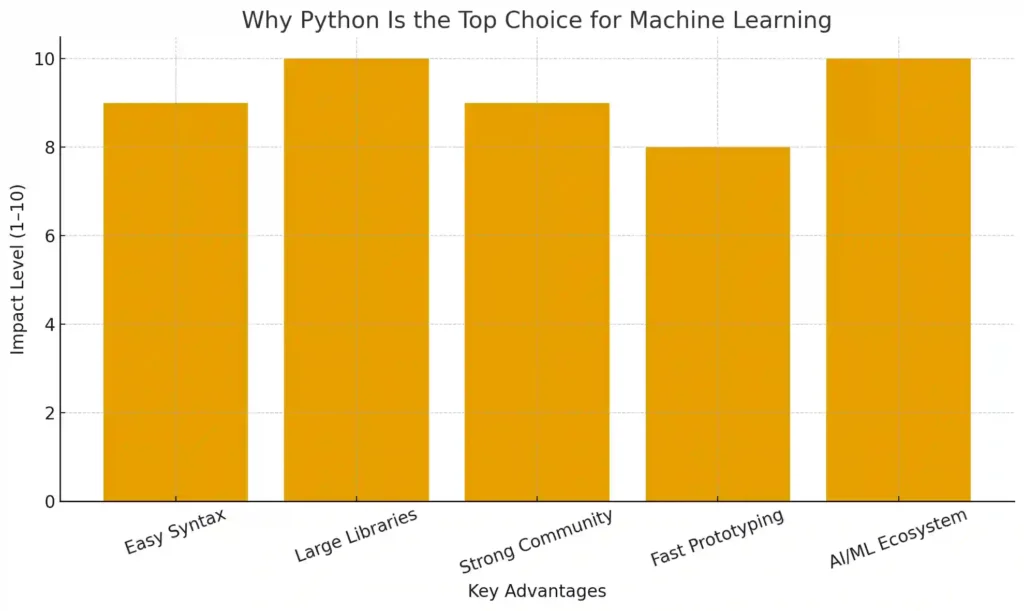If you’ve ever wondered why is Python used for machine learning, you’re in the right place. Whether you’re just starting or you’re evaluating which language your business should adopt for AI and ML development, understanding why Python has become the global standard will help you choose with confidence.
Let’s begin with a short story.
Several years ago, a junior developer named Sara joined a healthcare startup. Her first task was intimidating: build a model to predict early signs of diabetes. She expected long nights, complex math, and a language too difficult to understand quickly. But her worries faded when she discovered Python.
Instead of wrestling with syntax, Sara found herself thinking about real-world problems. Libraries like NumPy, Pandas, TensorFlow, and scikit-learn transformed the hardest ML tasks into manageable steps. Python didn’t just help her code—it helped her think.
This is the magic of Python.
And this article will show you exactly why the world has chosen it.
- Why Is Python Used for Machine Learning Reddit?
- Why Is Python Used for Machine Learning If It’s Slow?
- Is Python Good for Machine Learning and AI?
- Why Is Python Used for AI?
- Why Is Python Used for Data Science?
- What Is Machine Learning?
- Machine Learning Python Code Example
- Difference Between Python and Machine Learning
- Step-By-Step Guide: How Python Helps You Build ML Models
- Why You Should Choose Python With Confidence
- FAQ Section
Why Is Python Used for Machine Learning Reddit?
If you search “why is python used for machine learning reddit”, you’ll see thousands of threads in communities like r/learnpython and r/MachineLearning where experts, beginners, and professionals all give one consistent answer:
“Python is easy. Python is powerful. Python has everything you need.”
Here’s what Reddit users repeatedly highlight:
- A massive global community
- Quick troubleshooting through shared snippets
- Open-source support
- Endless tutorials
- Free resources for every level
In ML, community is everything. You will hit bugs. You will face confusing errors. And when you do, Python’s enormous ecosystem saves you time, money, and stress.
Why Is Python Used for Machine Learning If It’s Slow?
A surprising fact: Python itself does not run the heavy mathematical operations.
Machine learning libraries rely on:
- C for backend numerical operations
- C++ for speed-critical calculations
- CUDA for GPU acceleration (PyTorch / TensorFlow)
Python is simply the friendly wrapper—the steering wheel that controls a high-performance machine under the hood.
Think of it like driving a race car:
You don’t need to understand the engine to drive fast—you just need good controls.
Is Python Good for Machine Learning and AI?
Absolutely. In fact, Python is the industry leader for ML and AI due to:
✔ Human-Friendly Syntax
Python reads like English. This makes it ideal for students and engineers who want to focus on concepts instead of complexity.
✔ A Powerful Library Ecosystem
AI relies on math, data, optimization, neural networks, and visualization. Python has specialized libraries for each:
- PyTorch for deep learning
- Keras for fast model building
- OpenCV for computer vision
- NLTK for language processing
- Matplotlib for charts

✔ Fast Prototyping
Ideas change quickly in machine learning. Python lets you build, test, and improve models faster than almost any other language.
✔ Industry-Wide Adoption
Companies using Python for ML/AI include:
Google, Meta, Tesla, OpenAI, Netflix, and NASA.
Why Is Python Used for AI?
The answer is simple: AI requires constant experimentation—and Python makes experimenting easy.
Python is the backbone of:
- Deep learning research
- Reinforcement learning
- NLP (natural language processing)
- Robotics and automation
- Mathematical modeling
Its flexibility, readability, and scientific ecosystem make it the perfect choice for both scientists and production engineers.
Why Is Python Used for Data Science?
Before machine learning exploded, Python already dominated data science, thanks to libraries such as:
- Pandas → data cleaning and manipulation
- NumPy → numerical operations
- SciPy → scientific computing
- Seaborn → statistical visualization
Because ML grew out of data science, Python naturally became the preferred language for both fields.
What Is Machine Learning?
Machine learning is a method where computers learn patterns from data rather than being explicitly programmed.
A simple explanation:
- You provide examples.
- The computer finds patterns.
- It uses those patterns to make predictions.
Learn more here:
👉 Machine Learning (Wikipedia)
Machine Learning Python Code Example
A simple ML model using scikit-learn:
from sklearn.linear_model import LinearRegression
import numpy as np
# Training data
X = np.array([[1], [2], [3], [4]])
y = np.array([2, 4, 6, 8])
# Model
model = LinearRegression()
model.fit(X, y)
# Prediction
print(model.predict([[5]]))
In just a few lines, you’ve built a predictive model—that’s the beauty of Python.
Difference Between Python and Machine Learning
Many beginners confuse the two. Let’s clear that up:
- Python is a programming language.
- Machine Learning is a field of study.
Python provides the tools.
Machine learning provides the methods.
The relationship is similar to:
- A kitchen (Python)
- A recipe (machine learning)
Both needed. Both important. But fundamentally different.
Step-By-Step Guide: How Python Helps You Build ML Models
Step 1 — Install Python and ML Libraries
Step 2 — Collect and Load Data
Use Pandas for CSV, SQL, JSON, or API data.
Step 3 — Clean and Prepare Data
Handle missing values, scaling, encoding, and splitting.
Step 4 — Choose a Model
Examples:
- Random Forest
- Logistic Regression
- Neural Networks
- Support Vector Machines
Step 5 — Train the Model
Let the model learn patterns from data.
Step 6 — Evaluate Accuracy
Use metrics like MSE, accuracy, precision, recall.
Step 7 — Optimize
Tune hyperparameters using GridSearchCV or Optuna.
Step 8 — Deploy the Model
Use FastAPI, Flask, or cloud platforms.
Python fits perfectly into every step of the machine learning life cycle because it helps you collect data, build models, test them, and improve them easily.
Expert Insights & Quotes
“Python removes the friction between thinking and building. That’s why it dominates AI.”
— Dr. Adam Gibson, Deep Learning Researcher
“Python accelerates research because it lets us focus on ideas instead of syntax.”
— MIT AI Lab Contributor
Why You Should Choose Python With Confidence
If you’re learning machine learning or AI—or you’re choosing a tech stack for your company—here’s why you can trust Python:
- Easy for beginners
- Powerful for experts
- Largest ML/AI ecosystem in the world
- Global community support
- Backed by academia and industry
- Fastest prototyping language
- Works across cloud and enterprise tools
In short:
Python increases your chances of success—no matter your skill level.
FAQ Section
1. Why do we use Python in machine learning?
We use Python in machine learning because it’s simple to learn, has clean syntax, and lets developers focus on solving problems instead of struggling with complicated code. It also comes with thousands of powerful libraries—like NumPy, Pandas, scikit-learn, TensorFlow, and PyTorch—that handle most of the math and data processing behind ML.
In other words, Python removes the heavy lifting and lets you build and test models much faster. Its huge global community also means you get endless tutorials, support, and ready-made tools for almost every ML task.
2. Why is Python used for AI if it’s slow?
Many people think Python is “slow,” but here’s the real truth:
Python isn’t doing the heavy calculations.
Most AI libraries use extremely fast backend languages like C, C++, and CUDA. Python is simply the user-friendly interface that makes writing ML and AI code much easier.
So even though Python itself is slower than some compiled languages, the actual AI computations run at high speed under the hood. That’s why companies like Google, Tesla, Meta, and OpenAI still prefer Python—it’s the perfect balance of speed + simplicity.
3. Why is Python the best for AI?
Python is considered the best language for AI because:
It’s incredibly easy to read and write
It has the largest collection of AI/ML libraries in the world
It supports fast prototyping
It has strong community support
It works smoothly with data science tools
It integrates easily with cloud, production apps, and research tools
AI requires constant experimentation. Python helps developers test ideas quickly without wasting time on complex code structure. That’s why researchers, students, and big companies all choose Python for AI projects.
4. Is Python the main language for machine learning?
Yes. Python is the number one language for machine learning.
It’s used in almost every ML field, including:
Deep learning
Natural language processing
Computer vision
Recommendation systems
Predictive modeling
Automation and robotics
While other languages (like R, Java, or C++) are also used, Python dominates because it is flexible, beginner-friendly, and supported by an ecosystem built specifically for ML. Most modern ML tools are designed to work with Python first, and everything else second.

